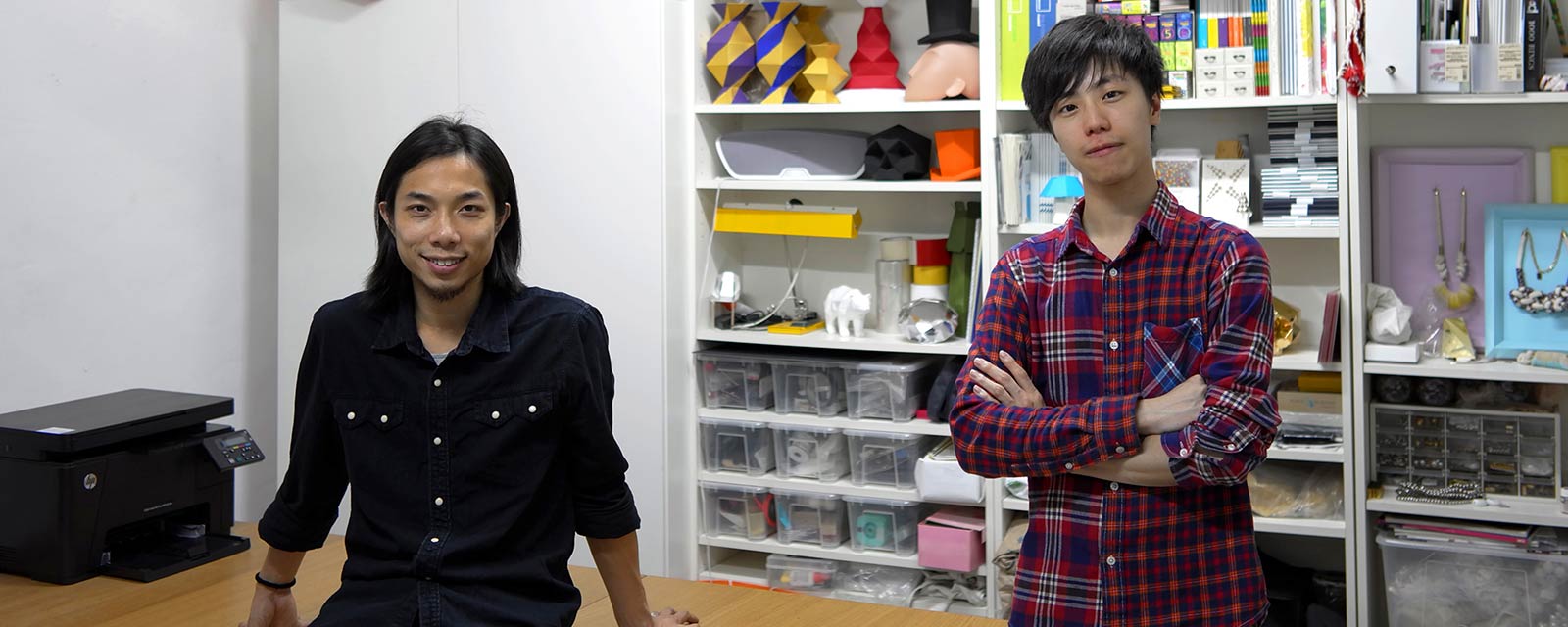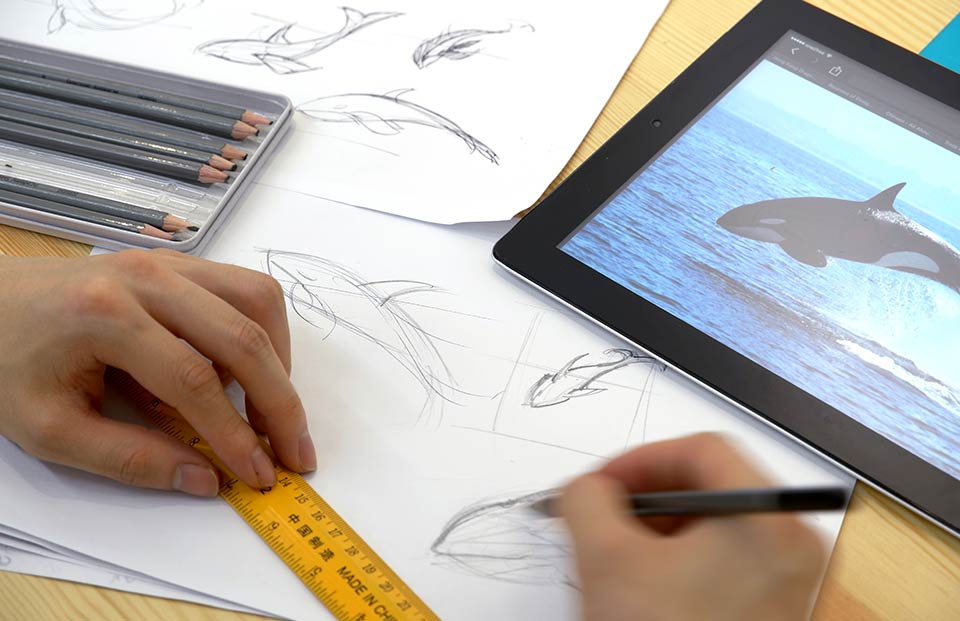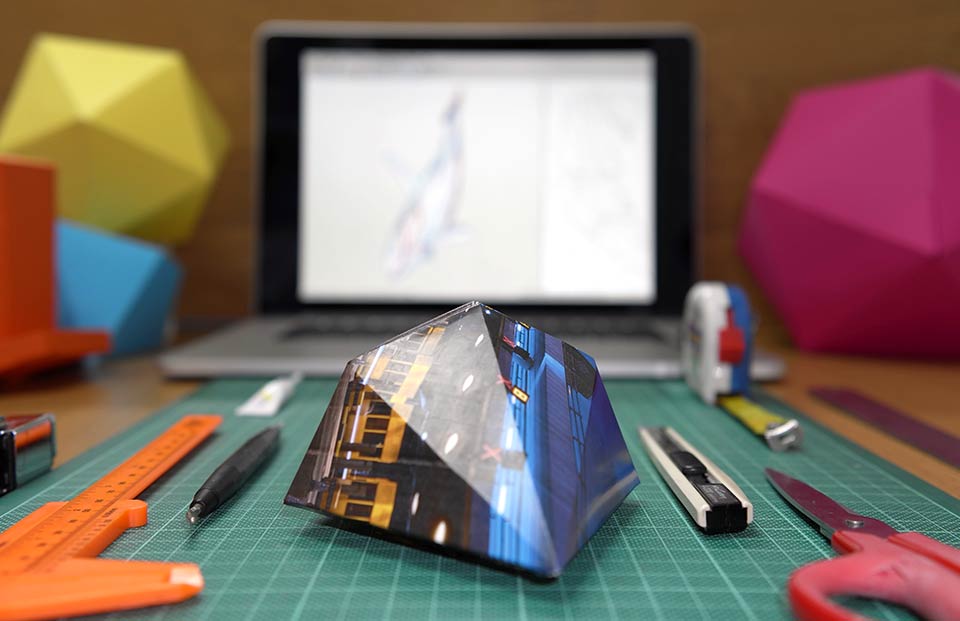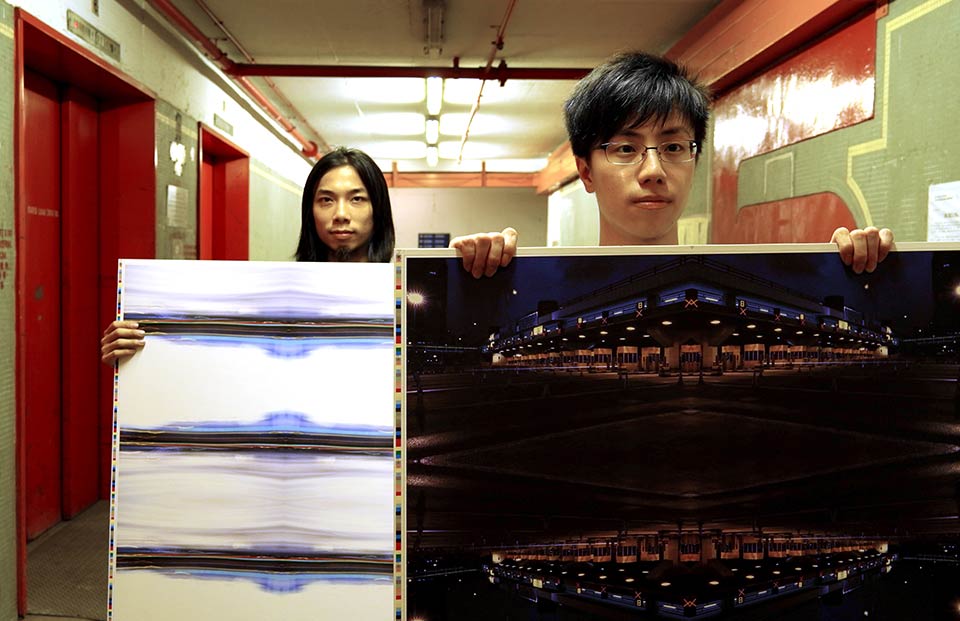
People tend to call Stickyline paper engineers, designers or artists but they don’t care too much about labeling. The only thing that really matters to them is creativity. Translated into Cantonese, Stickyline means "a little bit crazy" and this is exactly what they are.



Creating something that originates from a computer and evolves into reality by transferring the idea from the virtual reality into folded paper is a process that doesn’t fail to amaze them every day. They get inspired by everyday life and the things they see on our journey through it. Stickyline have been struggling against the challenges of working with paper and enjoying the reactions of people who are confronted with their work. At first they had to discover for themselves that gravity is a huge challenge for them: fragile paper pieces tend to collapse if they are built too big. On the other hand it’s impossible to build something really tiny.
Folding paper into geometric shapes follows a long tradition throughout the history of mankind and therefore they feel that keeping this handcraft alive is very important. Nowadays people are used to simply buying stuff while never questioning the production process behind this product. By giving people an understanding of handcrafts, this process becomes something visual and interesting.

INTERVIEW

Simply why?
We started our craft with a small project called Masked Creature, which was for DesignMart in Hong Kong, where we got the offer to sell our art. At first, we wanted to sell some paper products like CD holder etc. but one of our friends told us: "How much do you get if you sell one of these paper products? Why don't you create something amazing to impress others and make some noise? That would be a much bigger value compared to just selling things and get a small profit in two days!"
We can't agree more on that, so we came up with the idea to design a series of paper helmets in the shape of Hong Kong famous buildings. It looks quite cool and people can wear them and take interesting pictures. Besides, it actually became a platform to generate conversation and sharing.
We meet different people from everywhere in that few days, they shared their feelings about our work, which made us feel excited and inspired. We know we can do much more of this kind of art and craft in the future, that's how and why we started.
When and where were you born?
Mic was born in 1985 and Soilworm was born in 1983, Hong Kong, where Stickyline started in July 2011.
Where is your life centered at the moment?
Mic and Soilworm were studying industrial design, after graduation, Mic was a toy designer and Soilworm became a packaging designer in 2011. At the moment our life centers around working , movies and family time. We always thought we could do something as a designer / an artist, but then we started Stickyline.
Where is your work centered at the moment?
We both work in Hong Kong at the moment.
How old is your handcraft?
It has been almost three years since we began with the Masked Creature Paper Headpiece of Hong Kong’s famous buildings. Before that, Soilworm worked with paper in his packaging design company for five years.
How, when and where did your handcraft find you first?
One day, we decided to work on a funny project. We found some people who fold 3D comic objects out of paper like an Ironman Mask or comic figures. They even upload their working files for others who love them too, so we gave it a try and started out by making a helmet from an online game.
Once we finished the helmet, we realized that we can create a lot of things using the same method, and that we can create them in new shapes and forms, it doesn’t have to be another ironman or some famous comic figure.
When we were doing our first project Masked Creature, we designed 3D models on our computer and then transformed it into 2D lines and shapes, so that we can cut them out and assemble them like sewing a cloth. It is so amazing to bring our creation from virtual reality to the real world by using a computer and paper.
Is it Love? Profession? Faith? Determination? Curse?
We would call it Love and Faith. We like what we are doing and our work, feel proud of it when we present it to others, and we believe it is beautiful and worth recommending it to people.
Please tell us more about the history / origin of your handcraft?
People think that our handcraft was based in Japanese origami, but we think that our handcraft is more like 3D puzzling. We design this puzzle on our computer based on polygon calculation, generate the 2D pattern by simple paper engineering and afterwards we build these pieces by cutting, folding and assembling.
Do you control or change your handcraft or does your handcraft control or change you?
For us it is both, sometimes we control our craft to do what we want to, like bigger sizes, complicated shapes or to improve the skills.
At the same time it changes us, it sets up limits and rules for us which we must follow, like, we can't do something really small, easily to get dirty, so we got to keep it clean. It will collapse when it is too big and without proper support. This is the way it changes us. Paper is fragile but flexible, we just explore the possibilities.
How did your craft develop in the course of the past decades or centuries?
Beside the computer part, we were just using some simple techniques, such as maths, polygon, paper, tools, which already are linked with life, developing with manhood year by year.
How will your craft and you evolve together in the future?
We study industrial and product design at University, but we think design is a kind thinking method which can be applied in different areas.
In the beginning we don't know if it can be props for a photo shoot, a window display, a costume at a stage or an installation done by many people together. We will try out more possibilities with our art and craft in the future and work with different people to experience our work happen in various surroundings. We especially like the interaction with people.
Which part of the production process do you like best and why?
We like the assembling process the most, it’s like playing puzzle or Lego. We assemble each paper cut-out in an order, which is the most convenient way to get it done.
It’s our my favorite process because it’s so much fun to see the object starting from zero, and finally becoming a 3D object in your hands.
Which part of the production process is the most tricky one?
We think the production 'process' is the most tricky one. We design it step by step, if you don't follow the procedure, you can't work it out.
What is the biggest challenge?
The biggest challenge is the most exciting part: bringing our design from the virtual world to reality is not easy. Physics and gravity are our biggest challenge, we need to be friends with them. They are not easy to get hold of but they exist.
How does it feel to transform digital pixels into real, tangible originals?
Amazing!! Even if we saw it a thousands of times before in computer rendering, it is still a big surprise to feel it in scale 1:1, especially if it is something huge.
Please define „crazy“!
Crazy is a kind of thinking out of the box, when you do something unexpected, unusual, people think it is crazy.
Actually "Stickyline" means "a little bit crazy" when it translated to Cantonese. Yes we are just little bit crazy but not mad.
Ar you left or right handed?
Mic is left and Soilworm is right handed, which is a great combination for Stickyline and the creative process.
What is the most important tool for your work, other than your hands?
Besides our brain and computer, the most important tool is our stapler. It help us construct something big, really really big.
How do people react on your handcrafted products?
Surprised, they like our products, because they are something which one does not see in daily life. To many people it feels surreal.
What is the importance of handcrafts in current times?
People usually do not care about the process nowadays. They press a button and have light, they turn on the coffee machine and they get coffee. Handcrafts remind people of the process between raw materials and end product. By understanding the process, we can learn how things are being created, so we can improve or create something new based on that. Handcraft also let us touch and feel the making of objects. This is a experience you cannot obtain when only buy things.
Do you consider yourself an artist or a craftsman?
People see us as paper engineers, designers or artists, we don't care, we are just creative.
Our work involves a lot of handcraft, folding, cutting... , but after all it is the production process that counts, we need to design the shape, consider how to construct and apply our aesthetic sense to make it look good.
These techniques are more design and art like instead of craftsmanship in our understanding.
What is your favorite smell? Your favorite touch? Your favorite taste ? Your favorite sound? Your favorite dream?
We like the touch of paper, wood, metal, they just give us a reliable feeling and fine finishing. Especially when we used paper in the past, we find that papers can have different textures and so it offer s different touch, glossy, matte, rough, high density, thickness… Paper is very versatile.
What inspires you most?
Our daily life, most of our ideas come from our daily life. It is like a library where you can find new things all the time.
Who is your personal „handcraft jesus“ of all times?
Every person who is 'handcrafting' their life.
What would you recommend to somebody who wants to start learning your handcraft?
He/she must love to fold and cut first, our handcraft sometimes involves repeated steps, without it you cannot finish the job. And it would be good to have some understanding of paper, how to choose different kind of paper to work with, weakness and strength of it and how to make good use of it.
How should he/she start?
We would recommend to have some knowledge of computer 3D modeling, it is the beginning of our paper objects. By rendering on your computer, you already preview 90% of the object you design.
Start with some simple shapes and try not to be complicated at first. When you passed enough trial and error, you surely can handle something bigger.
History
PAPER FOLDING
To discover the roots of paper folding, we first need to trace the emergence of paper itself. Paper first appeared in China under the Eastern Han Dynasty – the creation of Cai Lun. In the 6th century, Buddhist monks took paper with them from China on their travels through Japan. The earliest evidence of paper being folded comes from a picture of a small paper boat in Johannes de Sacrobosco’s Tractatus de sphaera mundi way back in 1490.
However, it seems likely that paper folding has its roots even earlier – sometime between then and the invention of paper – in China burning folded paper was an important part of traditional funerals during the Sun Dynasy (905-1125AD) and evidence suggests it could date back even further. In Japan, folded paper butterflies (origami) were made for Shinto weddings during the Heian period (794-1185) and most likely even earlier. The tiny paper butterflies were supposed to represent the bride and the groom.
The paper folding of Stickyline brings together this ancient art with 3D modelling, something which itself has its roots in 1960’s Utah. In 1965 David Evans founded a computer science faculty here and it was this institute that would become the breeding ground for many of the basic 3D computer graphics techniques that form the basis of modern 3D modelling. As Robert Rivlin wrote in The Algorithmic Image: Graphic Visions of the Computer Age, "almost every influential person in the modern computer-graphics community either passed through the University of Utah or came into contact with it in some way".